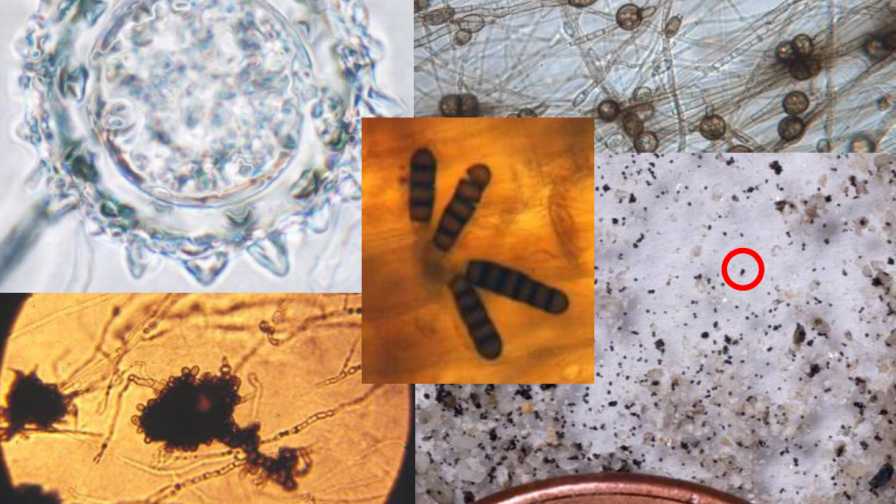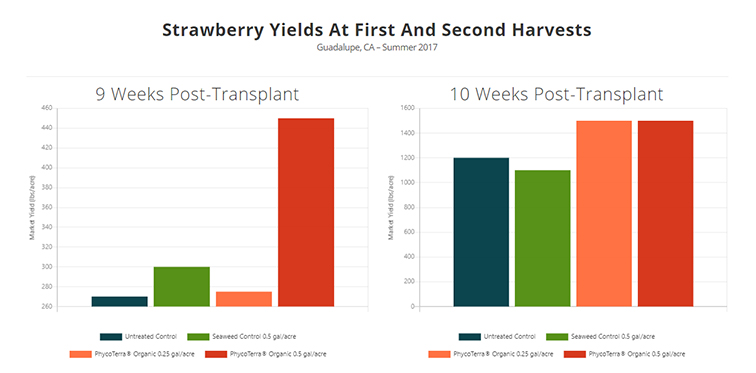What the Search for Life on Mars and Microbes on Earth Have in Common

In contrast to Martian soils, farm soils on Earth can be populated by plant pathogens such as Pythium (upper left), Fusarium (upper right), Verticillium (lower left), Macrophomina (lower right), and Thielaviopsis (center).
Photos by Steve Koike
World class researchers and engineers are moving rapidly ahead in the search for life on Mars. Elaborate, elegant, innovative equipment is being designed to equip two rovers for ambitious missions to the red planet. NASA’s Mars 2020 Rover will carry sensitive instrumentation designed to test for signs of life and the presence of environmental conditions required by biological organisms as we know them.
A subsurface radar imager will scan the ground for buried water or ice. The SuperCam imager has a series of cameras, including sensors for analyzing Martian soil cores for chemical compounds and identifying biosignatures. A luminescence scanner will be searching for organic compounds. The rover also will seek locations that likely could have harbored microorganisms in times past; such habitations would depend on the presence of subsurface water, protection from the deadly ultraviolet rays that bathe Mars, and other favorable conditions.
The European Space Agency is adding finishing touches to its Rosalind Franklin Mars Rover, named after the first person to develop a visual image (via X-ray crystallography) of the DNA double helix structure. The Rosalind Franklin Rover likewise will roam the planet’s surface while bearing many scientific tools. This six-wheeled unit will search for subsurface water and ice using a neutron spectrometer. An infrared microscope can examine grains of Martian soil minerals for the processes that could indicate biological activity. Both a laser spectrometer and organic molecule analyzer can search for organic compounds, biosignatures, and other signs of past life hidden in underground soil. We wish both NASA and the ESP great success with their missions as they complete their rovers and send them hurtling towards the red planet.
Microbial Life in Earth Fields
Back on Earth, other researchers likewise are focusing great attention in searching for microscopic life in the ground. Why this interest? Agriculturists, horticulturists, crop production researchers, plant pathologists, microbiologists, molecular scientists, soil chemists, and others in the research community recognize that crop soils are extremely complex ecological systems and the presence, absence, diversity, and balance of microorganisms can have a potentially significant influence on the success or lack of success of crop yields and quality. The recent research emphasis on “healthy soils” in large measure hinges on the nature of the microbial makeup in agricultural soils.
What Are We Looking for in Earth Soils?
Mars rover designers are hoping that their instruments will detect the faint traces that possibly indicate the existence of once living microorganisms. In addition, these scientists would be ecstatic over finding the actual physical presence of a single Martian microbe, dead or alive. Here in agricultural soils, researchers have the opposite challenge. Multitudes of microbes cram our farm soils at such a high rate, researchers struggle to make make sense of what their presence and numbers mean. From a simplistic, generalist point of view, one can start understanding soil microbial diversity by dividing microbes into a “beneficial/ecological” category and a more specialized, narrow group of “plant pathogenic” organisms.
Beneficial/Ecological Soil Microbes and Plant Health
Untold multitudes of resident bacteria, actinomycetes, protozoa, fungi, nematodes, viruses, and other classes of organisms that we generally cannot see with the unaided eye populate the soil microbial world. Researchers are helping us to gradually understand that these complex population structures indicate that the soil is microbially active and vibrant. Such microbially diverse soils can benefit our crops — and so we can call them “healthy soils.” However, “healthy soils” is still an under-developed concept. Because we do not know for sure which exact components (microbially, chemically, or otherwise) would define soil as “healthy.” The very term “healthy” itself is broad and likewise still needs more precise definition.
For that reason, much like the Mars rovers, researchers are devising means to drill, scoop, sample, sift, sort, and analyze soils. Their goal is to gain increased insight on which microbes soils contain and what relationship exists between their presence and soil health. Microbiologists and molecular scientists are developing methods to detect certain microbial species and measure their populations. They’re running studies to see if certain species are consistently associated with positive soil and field characteristics. If that link exists, researchers want to see if they can then identify biosignatures or “bio-indicators” of healthy soil. Two key goals of such research are (1) to see if the detection of such microbial species could be used as a predictor of soil health and (2) to determine if increasing and augmenting the populations of such species could result in healthy soils.
Destructive Microbes in Earth soil: Plant Pathogens
To experienced farmers and other agricultural professionals, the names are familiar. These are some of the destructive culprits (bacteria, fungi, nematodes) that reside in field soil and cause soilborne diseases: Agrobacterium, Aphanomyces, Armillaria, Ditylenchus, Erwinia, Fusarium, Heterodera, Macrophomina, Meloidogyne, Pectobacterium, Phytophthora, Plasmodiophora, Pratylenchus, Pythium, Rhizoctonia, Sclerotinia, Sclerotium, Thielaviopsis, Verticillium, Xiphinema. Within the context of soil microbial diversity, soilborne plant pathogens comprise a very small number of species and an even smaller proportion of the overall populations of microbes teeming in agricultural soils on Earth. As we know, however, the impact of such pathogens is significant and can cause loss of crop yields and quality.
Because of the economic impact of soilborne plant pathogens, developing methods to detect, identify, and quantify such microbes is a high research priority. Growers could gain a strategic advantage if they can know, before planting, whether a pathogen resides in their field at damaging levels. Because these organisms tend to persist in the ground for extended periods, growers are creating long-term plans on how to best deploy appropriate IPM options. Knowing the status of the enemy below ground will assist in such planning.
Soil Microbe Detection: Reliance on Technology
In contrast to Mars, which will soon have two exquisitely equipped scientific lab-on-wheels roaming around the landscape, our farms do not yet have remotely controlled, self-contained, soil sampling and testing rovers that can automatically assess the microbial condition of fields. What we do have, however, are highly trained and experienced professionals who are conducting research to increase our ability to detect and count soil microbes, both good and bad ones. In addition, the status of our detection technology is currently good and getting better.
Established extraction and culture methods can recover, identify, and count populations of some of the most damaging soil borne pathogens. DNA-based molecular techniques have become more efficient and sensitive in recent years and are adding greatly to our knowledge of soil microbial ecology. Other research in biochemistry is developing the means to find biosignatures that indicate the presence of certain microbes in sampled soil. Given the fast pace of technological development, perhaps before too long we will indeed see a six-wheeled unit motoring down the furrows of our fields, stopping here and there to scoop up samples of Earth dirt.










